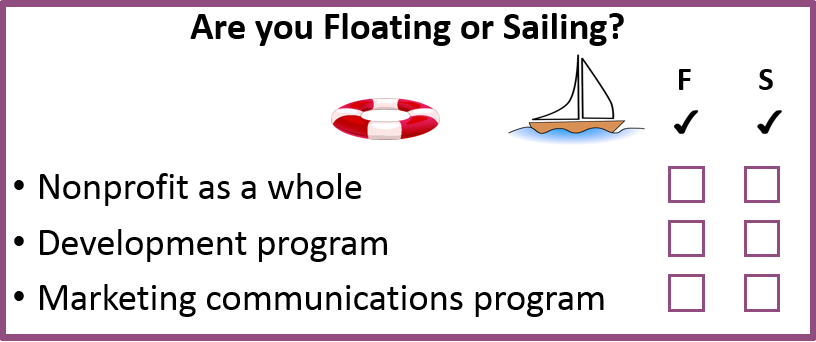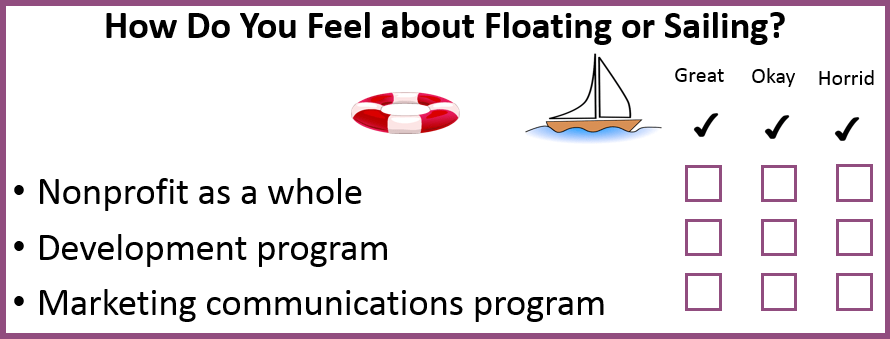
Are you content with your modus operandi?
A sailboat without a sail might float.
For a long time, in fact.
But without a sail, it can’t go anywhere, can’t fulfill its function.
Floating is insufficient.
– Seth Godin
For you to ask and answer
- Is your nonprofit floating, or sailing?
- Are your development efforts floating, or sailing?
- Are your marketing communications efforts floating, or sailing?
These are serious questions that deserve your serious consideration.
So… take a moment right now to answer these three questions for yourself.
Go ahead.
Put an “F” or an “S” next to each one of these.

Done?
Okay.
Do you have any “F”s?
If so, how do you feel about them?
I’ll give you a choice between “I feel great,” “I feel okay,” or “I feel horrid.”
Make a note of your quick, gut reaction to each one.
If your gut reaction is “great,” read no more. No one can teach you to swim if you don’t want to. You’re happy staying where you are. Just don’t complain that you’re not moving.
If your gut reaction is “horrid,” read on. I’m going to give you some suggestions to help you move forward.
If your gut reaction is “okay,” think a bit more about what you’re ambivalent about. Because “okay” is neither good nor bad; neither here nor there.
Personally, I’m not comfortable with “okay” as an answer. I want more than that. In fact, I’ve left jobs where the prevailing sentiment was “we’re doing fine, so stop trying to rock the boat.”
I’m a boat rocker.
You?
If you’re one too, continue reading.
How to Add a Sail to Your Nonprofit
You must decide on your mode-o-day. Is it retrench mode? Status quo mode? Or growth mode?
In 2008-2009, in the face of the great recession, a lot of nonprofits tightened their belts, sharpened their pencils, and set about eliminating programs to cut costs.
Other nonprofits approached things differently. They ramped up their fundraising efforts and even added programs in order to serve more people who were, increasingly, reliant on their help.
When the recession abated, the penny-pinchers found themselves in a weakened position.
You can’t shrink your way to greatness.
When you enable your workers (and your customers) to do more, connect more, produce more and get paid more, you create a positive system.
— Seth Godin
At least every three years you should have an organization-wide strategic planning retreat where you consider what mode you want to be in.
Scenario 1: Consider what would happen were you to decide to retrench.
If you were to pick up the red pencil in the face of anticipated funding cutbacks and/or increased expenses, what programs and staff would you have to cut?
Scenario 2: Consider what would happen were you to decide to remain as you are.
If you were to forgo attempting to generate additional revenues, what new programs would you be unable to add? What waiting lists would you have to cut off? What flexibility would you have to sacrifice? What unanticipated emergencies would you be unable to address.Status quo means you won’t grow.
Also consider whether you can even deliver the same results by employing the same-old strategies. Have things changed in your environment so that what used to work isn’t working as well anymore? If so, what might you need to experiment with in order to adapt to today’s realities?
Scenario 3: Consider what would happen were you to decide to grow.
If you were to endeavor to expand services to respond to current and emerging needs, how much additional money would you need to raise? Who would take the lead in making this happen? What efficiencies would you need to create? What resources would you need to add? What would be the role of your board is assuring the plan they approve is enacted?
Float or Sail?
When you face these alternative scenarios head on, your choices suddenly become clearer. Actions (and inaction) have consequences. If everyone is okay with Scenario One or Two, fine. Own this. And stop beating your board and yourself up for not giving more or asking more. You’ve decided not to go this route. You’ve decided to float. Floating can be okay, if it’s a conscious choice.
But remember: even floating is not always effortless. Make sure you’re doing everything you need to do to stay afloat given the reality of today’s marketplace — which still may mean not doing things exactly as you’ve always done them. If you don’t adapt, you may drown.
And if you choose Scenario Three, own that too. Hoist up your sail and put a wind beneath you by putting in place the infrastructure, plan and leadership you need to not just survive, but to thrive.
How to Add a Sail to Your Development Program
Once you’ve decided where you’re headed, you need a viable plan to get you there. Building a sustainable fundraising program that will sail you towards your goal requires an understanding of two things:
- Development is a long-term game. If it were short, you could simply walk.
- Development is a team sport. To sail swiftly and accurately, you need a full, experienced crew working seamlessly together.
Consider what it would take to develop a realistic long-term fundraising plan
You can go for short-term wins, but you’re kidding yourself if you think this is an effective way to go about fundraising. I’m talking about direct mail, special events, and even grants to an extent. Because all these strategies bring in first-time gifts. And every business knows it’s much less expensive to retain an existing customer than to acquire a brand new one.
What’s your experience converting first-time donors into ongoing ones? Have you read the Fundraising Effectiveness Project Report? For the last eight or so years it’s shown first-time donor retention to be alarmingly low. On average, only 23% of these supporters give again. So all the money and time you put into acquiring them is a complete and utter waste of resources. You’re losing, on average, $95 for every $100 you gain.
To turn things around requires a different focus. A focus on retention. Donor stewardship. Relationship-building. Assigning staff to do this work. Developing a database and CRM to support your efforts. And making it part of everyone’s job to put donors at the center of your mission.
Consider what it would take to develop an organization-wide culture of philanthropy.
Is fundraising in your organization treated as a “necessary evil?” If so, you’re in trouble. You can’t be successful over the long run if you stick a development officer in a corner and tell them to “go raise money.” Nor can you fob off the job on the development committee, absolving the rest of the board from this responsibility. Fundraising is a team sport. A communal endeavor. It’s got to be part of everyone’s job.
What could you do to get everyone’s focus on the mission, vision, and values of your organization and the role philanthropy plays in fulfilling that mission? Could you get leadership to embrace this role? Generally, people follow the leader. Then they follow their peers. So see how many of these statements are true for you, and how many you can work towards making true for you.
- Our executive director is personally involved in fundraising.
- Our board president is personally involved in fundraising.
- Most people in our organization act as ambassadors and build relationships.
- Everyone in our organization can articulate a case for giving.
- Fundraising is perceived as a mission aligned part of our organization.
- We put donor needs first and our internal systems support this.
How to Add a Sail to Your Marketing Communications Program
“Development” is often confused with purely “fundraising.” But really it’s fundraising and marketing communications combined. The two functions are inseparable. Marketing strategies let others know what values you enact; then help uncover the folks who share those values so you can target your fundraising efforts accordingly.
The goal isn’t to clear the table, the goal is to set the table.
–Seth Godin
Do you integrate development and marketing so the table is properly set for the next meal you’re about to serve up? Or does your development department have to beg and cajole the marketing staff to help them out whenever needs arise? How can you raise money for your cause if no one knows about the good work you’re doing? If no one is ‘hungry’ for your ‘meal?’
What would it take to integrate your fundraising and marketing communications functions?
Sadly, too often marketing and development are separate departments. Yet they’re often tasked with the same functions: (1) which “product” to offer, (2) which customers to target, and (3) which channel(s) to message in. If they work at cross purposes, your branding becomes incoherent.
If you want to make life easier for yourself, I strongly encourage you to align these two functions. Integrate your departments. Understand that from the outside looking in, you are ONE organization. No one cares which department crafted which message. What folks do care about is when they are bombarded by too many different messages — from different departments — with different calls to action. It’s confusing. What are they supposed to do first? It’s up to you to decide on your top priority for their time, interest and money.
Ideas (including missions, values and visions) that spread, win. And marketing is just the art of getting ideas to spread and take wing.
Ready to start sailing?
REMINDER:

Save even more when you buy four!
Should you ever wish to bat any ideas around with me, I’m available for up to four discounted Hours of Power. Please check this out if you think I can be helpful to you.
And don’t hesitate to ask if you have questions.
Email me at Claire@clairification.com.





